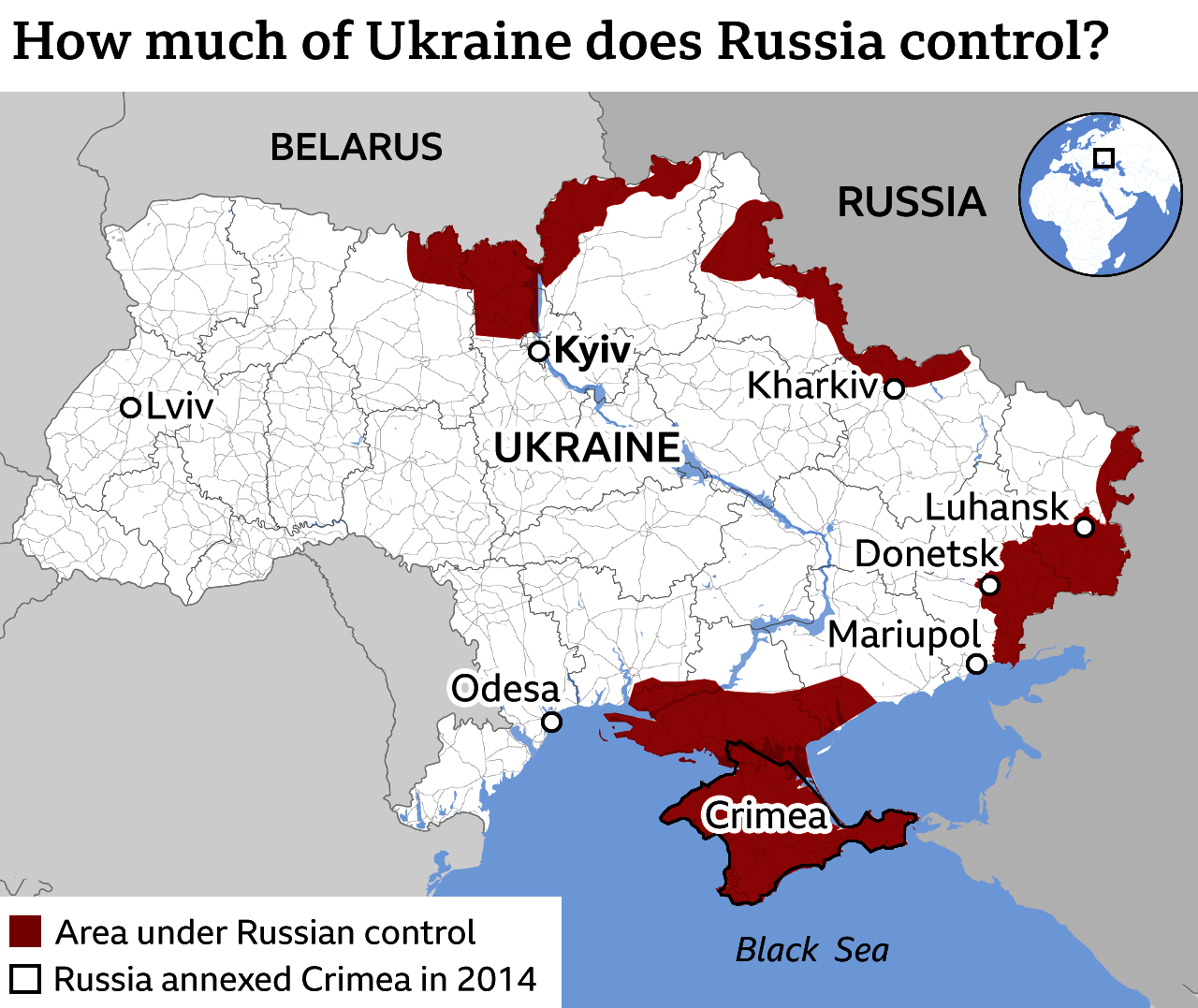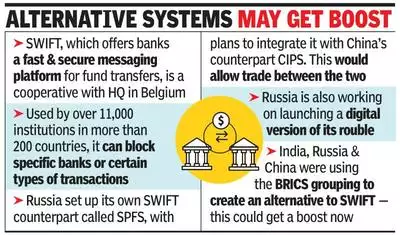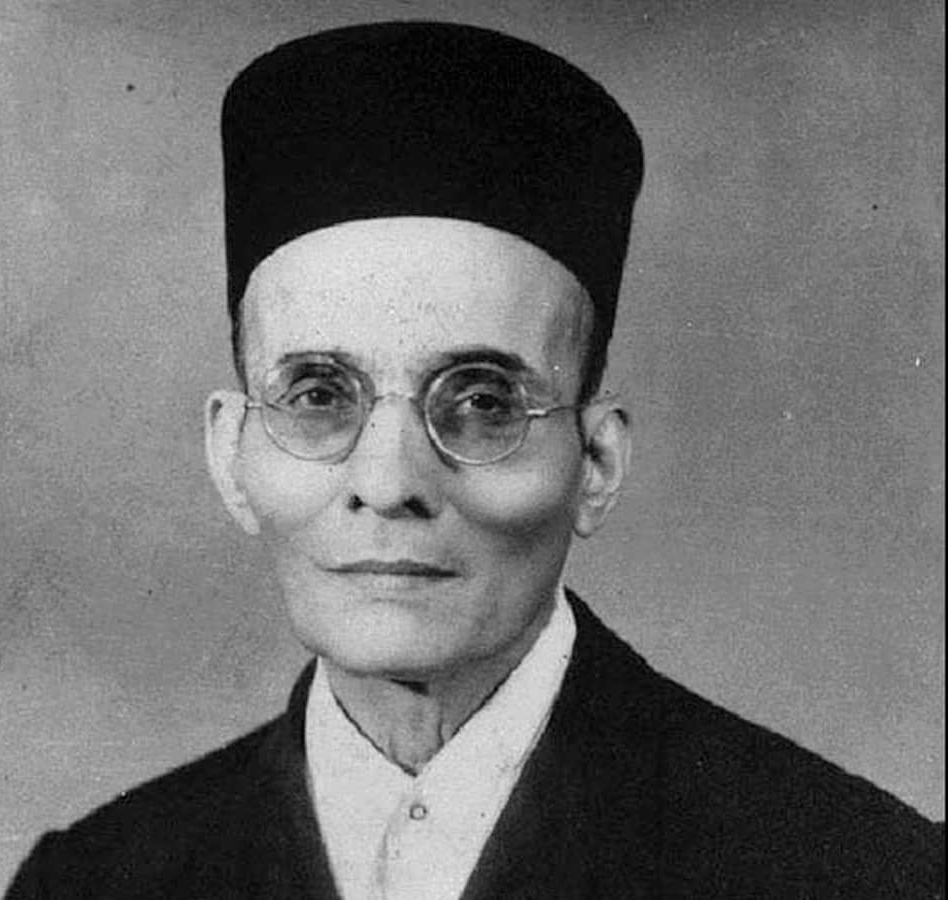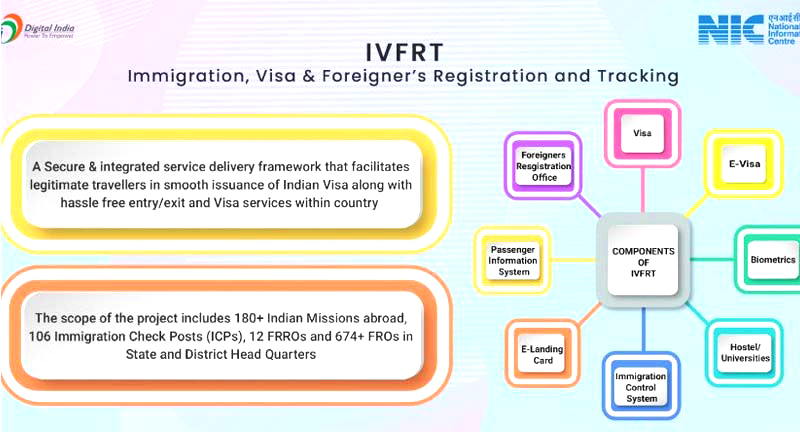International Relations
UN Resolution Condemning Russian Aggression
For Prelims: Location of Ukraine and Neighbourhood, United Nations Security Council, Russia, Ukraine, Veto Power, LAC, QUAD.
For Mains: Important International Institutions, Global Groupings, International Treaties & Agreements, India and its Neighbourhood, Effect of Policies & Politics of Countries on India's Interests, India’s Stand on the Resolution, Reasons for India’s Stand and Way Forward.
Why in News?
Recently, the United Nation Security Council voted on the draft resolution by the US and Albania that sought to condemn Russian aggression and called for the immediate cessation of violence and withdrawal of Russian military from Ukraine.
What was the Resolution About?
- The Council’s resolution reaffirmed its commitment to the sovereignty, independence, unity and territorial integrity of Ukraine within its internationally recognised borders.
- The resolution “deplores in the strongest terms Russia’s aggression against Ukraine” and decides that Russia “shall immediately cease its use of force against Ukraine and shall refrain from any further unlawful threat or use of force against any UN member state”.
- The original version was too strong, as it invoked UN Chapter VII, which authorises the use of force against Russian troops in Ukraine.
- It also asked Russia to “immediately and unconditionally reverse the decision related to the status of certain areas of Donetsk and Luhansk regions of Ukraine”.
- The resolution did not pass since the permanent member and President of the Security Council for the month of February Russia, used its veto.
- The resolution received 11 votes in favour and three abstentions. China and India both abstained.
What is India’s Stand on the Current Crisis?
- India is deeply disturbed by the recent turn of developments in Ukraine. India urged that all efforts shall be made for the immediate cessation of violence and hostilities.
- Dialogue is the only answer to settling differences and disputes, however daunting that may appear at this moment. It is a matter of regret that the path of diplomacy was given up.
- With this India has managed to hold its balancing act again, despite the considerable pressures from the West to vote against Russia, as well as pressures from Russia to support it.
- Earlier in January 2022, India abstained from a vote on whether to hold a discussion on the Ukraine situation, and also indicated support for Russia’s legitimate security interests.
- India has been in touch with all sides, urging parties concerned to return to the negotiating table.
What is India’s Dilemma?
- India’s strategic ambivalence at this big turning point in world geopolitics is born out of its friendships and strategic partnerships on both sides.
- Russia is India’s biggest and time tested supplier of defence weapons. Despite its growing friendship with China, Russia has boosted India’s defence capabilities with the S-400 air defence system.
- India’s Defence Minister visited Russia at the height of India’s crisis with the Chinese Army at the Line of Actual Control (LAC) in June 2020. And Russia has stood behind India at the UNSC on all issues.
- At the same time, India has a deep partnership with the United States, which includes defence pacts, trade and investment, technology, and not least, a huge connection through the Indian diaspora and people to people contacts.
- With thousands of students leaving Indian shores every year to study in American universities.
- The same with Europe. Additionally, France as one of the P-5 (Permanent Five) is a vital friend of India in the UN Security Council. India needs all these friends as it deals with China’s moves at the LAC.
What is the Need of the Hour for India?
- Dealing first-hand with the consequences of Chinese expansionism and adventurism on its own borders, and a South Asian region suddenly vacated by America's military presence in Afghanistan.
- India needs both the US and Russia to fend off a Chinese strategic and geo-economic threat in Asia.
- If the India-Russia partnership is critical on land in Asia, the QUAD - an alliance between America, Japan, Australia and India - is imperative when it comes to countering Chinese maritime expansionism in the Indian Ocean region.
- The imperative to counter China remains a cornerstone of Indian foreign policy, everything-including Delhi's position on Russian action in Ukraine- flows from that.
- Within India’s foreign policy establishment, there is ongoing debate on what India might gain or lose by its neutrality and the consequences of siding with the West.
- There is also the thinking that the West cannot afford to cut away from India at this point, as it needs India’s markets, and India’s heft as a democracy as it seeks partners to contain China.
- But there is an inbuilt tension in this realist position that speaks about rules violations in one part of the world but does not call it out in another.
- Therefore, India’s position may have to be calibrated constantly as the situation evolves especially if confronted by growing casualties in Ukraine.
International Relations
Russian Banks Excluded from SWIFT
For Prelims: Society for Worldwide Interbank Financial Telecommunication (SWIFT), System for Transfer of Financial Messages, Cryptocurrencies.
For Mains: Bilateral Groupings & Agreements , Russia’s war over Ukraine,Impact of sanctions on Russia, SWIFT and its Significance.
Why in the News?
Recently, in a move to counter Russia’s war over Ukraine, the US and the European Commission issued a joint statement to exclude some Russian banks from the Society for Worldwide Interbank Financial Telecommunication (SWIFT) messaging system.
- The intention behind this action is to further isolate Russia from the international financial system.
- The move against Russia is only partly implemented for now, with only some Russian banks being covered.
- The option of expanding it further to a pan-country ban is something that the US and its allies are holding back as a further escalatory move.
What is the SWIFT Messaging System?
- SWIFT provides the trusted messaging platform that enables financial institutions to exchange information about global monetary transactions such as money transfers.
- While SWIFT does not actually move money, it operates as a middleman to verify information of transactions by providing secure financial messaging services to more than 11,000 banks in over 200 countries.
- Most of the world trade takes place with financial messaging passing through SWIFT.
- It was established in 1973 and is based in Belgium.
- It is overseen by the central banks from eleven industrial countries: Canada, France, Germany, Italy, Japan, the Netherlands, Sweden, Switzerland, the United Kingdom, and the United States, besides Belgium.
- India’s financial system has access to the SWIFT.
- Prior to SWIFT, the only reliable means of message confirmation for international funds transfer was Telex.
- It was discontinued due to a range of issues such as low speed, security concerns, and a free message format.
What will be Impact on Russia?
- Russia is heavily reliant on the SWIFT platform for its key natural resources trade, especially the payments for its oil and gas exports.
- It will freeze the assets of Russia’s central bank, which would stop Russia from “using its war chest”, referring to its forex reserves.
- Further, the curbs on Russia’s central bank will prevent it from dipping into its forex deposits to limit the effect of sanctions.
- Targeting only some Russian banks seems to be aimed at both keeping the option of further escalation open.
- it also envisages that the sanctions have the maximum possible impact on Russia, but prevent a major impact on European companies dealing with Russian banks for payments for their gas imports
- There is going to be a catastrophe on the Russian currency market.
- Prior to this, only one country had been cut off from SWIFT — Iran. It resulted in it losing a third of its foreign trade.
How did Russia React?
- Russia has worked on alternatives, including the SPFS (System for Transfer of Financial Messages) — an equivalent of the SWIFT financial transfer system developed by the Central Bank of Russia.
- Russia is reported to be collaborating with the Chinese on a possible venture which will be a potential challenger to SWIFT.
- There are plans to integrate it with China's Cross-border Inter-bank Payments System (CIPS).
What are Other Global Alternatives to SWIFT?
- There are financial technology companies like Ripple, which has been offering its platform based on interledger protocol (the same technology behind cryptocurrencies) as an alternative.
- Cryptocurrencies are another avenue for cross border remittances. Russia has also been working on a 'digital' rouble, which is still not launched.
How will the Sanctions Impact India?
- Following the collapse of the Soviet Union in 1991, India had entered into a rupee-rouble trade arrangement with Russia to ensure that defence and other imports could continue.
- In 2018, a pilot project was run where Indian importers paid in roubles for diamond imports.
- These payments were made to the Indian branch of Russia's Sberbank. SBI and Canara Bank have a joint venture (The Commercial Indo Bank), which might be able to help Indians there.
Governance
Operation Ganga
For Prelims: India’s Evacuation Operations, Location of Ukraine and other neighbouring countries
For Mains: Ukraine-Russia Conflict and India’s Interests in Ukraine and Russia, Implications of Conflict on India.
Why in News?
The Government of India has launched a ‘multi-pronged’ initiative named ‘Operation Ganga’.
- A dedicated Twitter handle ‘OpGanga Helpline’ to assist Indian evacuation from Ukraine has also been announced.
- The tensions between Russia and Ukraine are currently heightened, with war erupting in Ukraine after the Russian military launched a series of attacks recently.
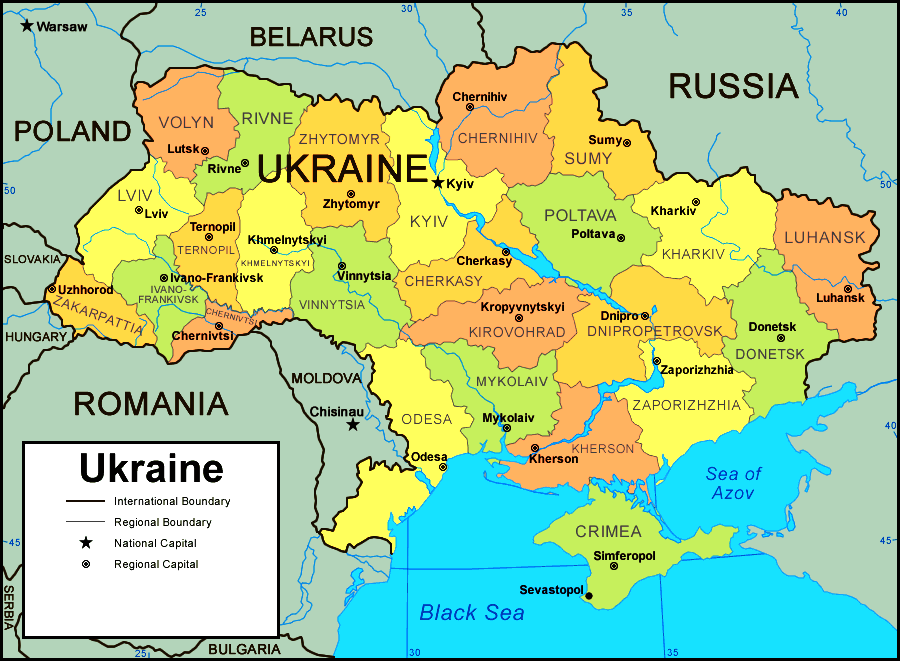
What is Operation Ganga?
- It is an evacuation mission to bring back all the Indian nationals who are currently stranded in Ukraine.
- There were around 20,000 Indians including students stuck in Ukraine.
- Till now, three Air India flights have been able to bring back more than 900 Indians from Ukraine to India.
- The Indian evacuation flights are operating from neighbouring countries like Romania and Hungary.
- The government is also facilitating evacuation of stranded Indians from its borders crossing Romania, Hungary, Poland and Slovakia.
| What are the Evacuation Operations carried out by India? | |
| Operation Ganga (2022): |
|
|
|
|
|
|
Evacuation from Brussels (2016): |
|
| Operation Raahat (2015): |
|
|
Operation Maitri (2015): |
|
|
Operation Safe Homecoming (2011): |
|
|
Operation Sukoon (2006): |
|
|
1990 Kuwait Airlift (1990): |
|
Governance
World NGO Day
For Prelims: World NGO Day, Non-Governmental Organisations.
For Mains: Role of Non-Governmental Organisations in the Indian Democracy, Issues associated with NGOs, Challenges faced by NGOs and way ahead
Why in News?
Every year, 27th February is observed as the World NGO day all over the world.
- India has over three million Non-Governmental Organisations (NGO) that work across a range of arenas and play important roles of facilitator, catalyst or partner in bringing social transformation.
What is the History of World NGO Day?
- The day assumed its official status when 12-member countries of the IX Baltic Sea NGO Forum on 17th April 2010 formally recognised it.
- In 2012, the forum's Final Statement Resolution adopted the day.
- Although the day was recognised officially in 2010, it was only in 2014, that for the first time World NGO Day was observed by the United Nations.
- The main man behind this day was Marcis Liors Skadmanis, an UK-based social entrepreneur, who inaugurated the 2014 World NGO Day.
- The day was conceived to spread awareness of the tremendous contributions of NGOs all around the world and honour the relentless efforts of the social workers both in the public and private sectors.
What is the Role of NGOs in Indian Democracy?
- Bridging the Gap:
- NGOs endeavour to plug gaps in the government’s programmes and reach out to sections of people often left untouched by state projects. For example, providing aid to migrant workers in Covid-19 crisis.
- In the present scenario, when India is still combating Covid-19, non-profits have been on the ground, working tirelessly to directly supplement the government’s efforts to bring relief and actively engage in vaccination drives to the most vulnerable communities.
- These NGOs also look into accelerating activities like
- Issues dealing with poverty alleviation, water, environment, women’s rights and literacy.
- They have been dynamic in almost all sectors: Health, education, livelihood in rural and urban areas etc.
- Role of an Enabler:
- Community-level outfits and self-help groups are critical for bringing any change in the ground.
- In the past, such grass roots organisations have been enabled by collaborations with bigger NGOs and research agencies that have access to foreign funding.
- Acting as a Pressure Group:
- There are political NGOs that mobilise public opinion against government’s policies and actions.
- To the extent such NGOs are able to educate the public and put pressure on public policy, they act as important pressure groups in a democracy.
- There are political NGOs that mobilise public opinion against government’s policies and actions.
- Role in Participative Governance:
- Many civil society initiatives have contributed to some of the path-breaking laws in the country, including the Environmental Protection Act-1986, Right to Education Act-2009, Forests Rights Act-2006 and Right to Information Act-2005, Mahatma Gandhi National Rural Employment Guarantee Act (MNREGA) Juvenile Justice , Integrated Child Protection Scheme (ICPS).
- NGOs also partnered with the government to successfully implement major campaigns like Swachh Bharat Abiyaan and Sarva Siksha Abiyaan.
- Acting as a Social Mediator:
- Social inter-mediation is an intervention of different levels of society by various agents to change social and behavioural attitudes within the prevailing social environment for achieving desired results of change in society.
- In Indian context wherein people are still steeped in superstition, faith, belief and custom, NGOs act as catalysts and create awareness among people.
- Social inter-mediation is an intervention of different levels of society by various agents to change social and behavioural attitudes within the prevailing social environment for achieving desired results of change in society.
What are the issues Emanating from NGOs?
- Lack of Credibility:
- During the last few years, numerous organisations have mushroomed which claim to work for the cause of helping the poor.
- Under the garb of being an NGO, these NGOs often mint money from donors and are also involved in money laundering activities.
- During the last few years, numerous organisations have mushroomed which claim to work for the cause of helping the poor.
- Lack of Transparency:
- India’s disproportionate number of NGOs and the sector’s lack of transparency and accountability is clearly an issue that needs reforms.
- Further the allegations of corruption against NGOs are ignored. In the past many NGOs were blacklisted after being found to have indulged in misappropriation of funds.
- India’s disproportionate number of NGOs and the sector’s lack of transparency and accountability is clearly an issue that needs reforms.
What are the main Challenges NGOs Face?
- Lack of Funds:
- Many NGOs find it difficult to garner sufficient and continuous funding for their work. Gaining access to appropriate donors is a major component of this challenge.
- Earlier, the Union Ministry of Home Affairs (MHA) cancelled the Foreign Contribution (Regulation) Act (FCRA), 2010 registration of various Non-Governmental Organisations (NGOs).
- Suspension of FCRA licence means that the NGO can no longer receive fresh foreign funds from donors pending a probe by the Home Ministry. The FCRA is mandatory for associations and NGOs to receive foreign funds.
- Absence of Strategic Planning:
- Many NGOs suffer from the lack of a cohesive, strategic plan that would facilitate success in their activities and mission, rendering them unable to effectively raise and capitalize on financial support.
- Poor Governance and Networking:
- Many NGOs have a deficit of understanding as to why they must have a Board and how to set one up.
- Poor or disorganized networking is another major challenge, as it can cause duplicated efforts, time inefficiencies, conflicting strategies and an inability to learn from experience.
- Many NGOs do not maximize the use of current technologies that could facilitate better communication and networking.
- Limited Capacity:
- NGOs often lack the technical and organizational capacity to implement and fulfill their mission, and few are willing or able to invest in training for capacity building.
- Weak capacity affects fundraising ability, governance, leadership and technical areas.
- Development Approaches:
- Many NGOs favor a “hardware” approach to development through building infrastructure and providing services instead of empowering people and institutions locally.
Way Forward
- India is committed to SDGs till 2030 and a long-term strategy is important to keep the focus while also pursuing sustainable growth and development.
- It is, however, important to note that success of a long-term strategy depends not only on the lessons learnt from implementing the short- or medium-term development strategies, but also cooperation and coordination from various sectors — the government, India Inc and NGOs.
- Capacity building and training can help to provide crucial new skills. NGOs can then more readily train staff and cultivate the necessary skills within the organization to address challenges going forward.
- It is necessary to regulate corrupt NGOs, however excessive regulation on foreign contribution may affect working of the NGOs which are helpful in implementing government schemes at the grassroots.
Indian History
Veer Savarkar
For Prelims: Veer Savarkar, Morley-Minto reform (Indian Councils Act 1909), Abhinav Bharat Society, India House, Free India Society, Hindu Mahasabha
For Mains: Veer Savarkar and his role in freedom struggle, Veer Savarkar
Why in News?
Recently, the Prime Minister has paid tributes to freedom fighter Veer Savarkar on his Punya tithi (26th February).
Who was Veer Savarkar?
- Birth: Born on 28th May,1883 in Bhagur, a village near Nashik in Maharashtra.
- Related Organisations and Work:
- Founded a secret society called Abhinav Bharat Society.
- Went to the United Kingdom and was involved with organizations such as India House and the Free India Society.
- He was the president of Hindu Mahasabha from 1937 to 1943.
- Savarkar wrote a book titled ‘The History of the War of Indian Independence’ in which he wrote about the guerilla warfare tricks used in 1857 Sepoy Mutiny.
- He also wrote the book ‘Hindutva: who is hindu?’.
- Trial and Sentences:
- Arrested in 1909 on charges of plotting an armed revolt against the Morley-Minto reform (Indian Councils Act 1909).
- Arrested in 1910 for his connections with the revolutionary group India House.
- One of the charges on Savarkar was abetment to murder of Nashik Collector Jackson and the second was waging a conspiracy under Indian Penal Code 121-A against the King emperor.
- Following the two trials, Savarkar was convicted and sentenced to 50-years imprisonment also known as Kala Pani and transported in 1911 to the Cellular Jail in the Andaman and Nicobar Islands.
- Death: He died on 26th February 1966 due to fasting on his own wish of death.
Abhinav Bharat Society (Young India Society)
- It was a secret society founded by Vinayak Damodar Savarkar and his brother Ganesh Damodar Savarkar in 1904.
- Initially founded at Nasik as Mitra Mela, the society was associated with several revolutionaries and political activists with branches in various parts of India and London.
India House
- It was founded by Shyamji Kishan Verma in 1905 in London.
- It was opened to promote nationalist views among Indian students in London.
Free India Society
- Savarkar went to London in 1906. He soon founded the Free India Society, based on the thoughts of the Italian nationalist Giuseppe Mazzini (Savarkar had written a biography of Mazzini).
Hindu Mahasabha
- Akhil Bharat Hindu Mahasabha is one of the oldest organizations of India as it was formed in 1907. Eminent leaders extended this Organization in 1915 on ALL India basis.
- The Eminent personalities who founded this Organisation and who presided over the ALL INDIA Sessions held include Pandit Madan Mohan Malaviya, Lal Lajpat Rai, Veer Vinayak Damodar Savarkar, etc.
Science & Technology
Variability in Ct Values
For Prelims: Viral Load, Ct Values, RT-PCR Test.
For Mains: Significance of Ct Value in RT-PCR Test and factors of its Variability.
Why in News?
Recently, a survey of 700 laboratories in the US using standardised proficiency testing material from the same batch found a variability in Ct (Cycle Threshold) values by 14 cycles.
- Even within the same test at the same lab the Ct values could vary by 3 cycles for different target genes, and up to 12 cycles for the same target gene across labs.
What is the Cause of Variability in Ct Values?
- Dynamic Measure and Evolves Rapidly:
- A low Ct value at the time of diagnosis does not mean that it will stay low the next day.
- Similarly, a swab done very early in the infection may reveal a high Ct value, which if repeated a day or two later, may reveal a lower Ct value.
- It is possible for this reason that Ct values have not been convincingly correlated with disease severity, and serve no role in predicting the trajectory for a patient (yet, this is commonly used as an argument to prescribe tests and medicines).
- Influence of Technical and Logistical factors:
- The way specimens are collected, the type of specimen, the medium in which the swab is transported, the time lag between collection of the specimen and processing.
- All of this can influence the quantum of viral genetic material present, and subsequently, the Ct value.
What is RT-PCR Test and Ct Value?
- RT-PCR Tests:
- In an RT-PCR (Reverse Transcription Polymerase Chain Reaction) test, RNA (Ribonucleic acid) is extracted from the swab collected from the patient. It is then converted into DNA (Deoxyribonucleic acid), which is then amplified.
- Amplification refers to the process of creating multiple copies of the genetic material - in this case, DNA.
- This improves the ability of the test to detect the presence of the virus.
- Amplification takes place through a series of cycles—one copy becomes two, two becomes four, and so on—and it is after multiple cycles that a detectable amount of virus is produced.
- Ct Value:
- Ct is short for ‘Cycle Threshold’.
- The Ct value refers to the number of cycles after which the virus can be detected.
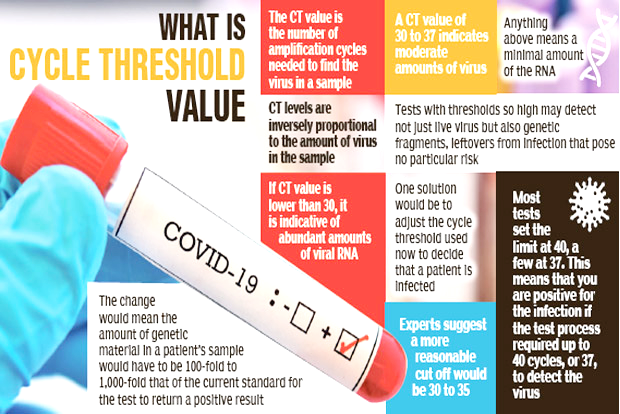
- If a higher number of cycles is required, it implies that the virus went undetected when the number of cycles was lower.
- The lower the Ct value, the higher the viral load-because the virus has been spotted after fewer cycles.
- It has been found that the time since the onset of symptoms has a stronger relationship with Ct values as compared to the severity of the disease.
What is Viral Load?
- It refers to the amount of genetic material, commonly RNA, of a virus present in an infected person’s blood.
- This is expressed as the total number of viral particles present in each millilitre of blood.
- A higher viral load in the blood means that the virus is replicating and the infection is progressing.
- An infected person with a high viral load is more likely to shed more virus particles, in the process known as “viral shedding”.
Important Facts For Prelims
India has the Opportunity to Export more Wheat
Why in News?
The Russia-Ukraine conflict may give India an opportunity to ship more wheat in the global markets.
What are the Key Points?
- More than a quarter of the world's wheat export comes from Russia and Ukraine.
- Russia is the world's largest exporter of wheat, accounting for more than 18% of international exports.
- In 2019, Russia and Ukraine together exported more than a quarter (25.4 %) of the world's wheat.
- The top five countries that exported the highest dollar-value worth of wheat include Russia > United States > Canada > France > Ukraine.
- Egypt is the world's biggest importer of wheat.
- Turkey is also a big spender on Russian and Ukrainian wheat with 74% of its imports coming from those two countries in 2019.
- India is the second largest producer of wheat with a share of around 13.5% of world total production.
- India produces around 107.59 MT of wheat annually while a major chunk of it goes towards domestic consumption.
- India accounts for even less than 1% in world wheat export. However, its share has increased from 0.14% in 2016 to 0.54% in 2020.
- Presently, India's central pool stands at 24.2 million tonnes, twice more than the buffer and strategic needs.
What are the Key Points related to Wheat?
- About
- This is the second most important cereal crop in India after rice.
- It is the main food crop, in northand north-western part of the country.
- Wheat is a rabi crop that requires a cool growing season and bright sunshine at the time of ripening.
- Success of the Green Revolution contributed to the growth of Rabi crops, especially wheat.
- Macro Management Mode of Agriculture, National Food Security Mission and Rashtriya Krishi Vikas Yojana are few government initiatives to support wheat cultivation.
- Temperature: Between 10-15°C (Sowing time) and 21-26°C (Ripening & Harvesting) with bright sunlight.
- Rainfall: Around 75-100 cm.
- Soil Type: Well-drained fertile loamy and clayey loamy (Ganga-Satluj plains and black soil region of the Deccan).
- Top Wheat Producing States: Uttar Pradesh > Punjab > Haryana>Madhya Pradesh > Rajasthan> Bihar>Gujarat
Important Facts For Prelims
Rashtriya Vayoshri Yojana
Why in News?
The MInistry of Social Justice and Empowerment will distribute 4,800 daily living aids and assistive devices among 895 senior citizen beneficiaries under Rashtriya Vayoshri Yojana (RVY).
What is Rashtriya Vayoshree Yojana?
- About:
- It was launched in 2017 by the Ministry of Social Justice and Empowerment.
- It is a central sector scheme funded from the Senior Citizens’ Welfare Fund. The fund was notified in the year 2016.
- All unclaimed amounts from small savings accounts, PPF and EPF are transferred to this fund.
- Aim:
- It aims to provide aids and assistive living devices to senior citizens belonging to Below Poverty Line (BPL) category who suffer from age-related disabilities such as low vision, hearing impairment, loss of teeth and locomotor disabilities.
- The aids and assistive devices, viz walking sticks, elbow crutches, walkers/crutches, tripods/quad pods, hearing aids, wheelchairs, artificial dentures and spectacles are provided to eligible beneficiaries.
- As per the Census figures of 2011, the population of senior citizens in India is 10.38 crore. More than 70% of the population of senior citizens live in rural areas of the country. A sizeable percentage (5.2%) of the senior citizens suffers from some sort of disabilities related to old age.
- It aims to provide aids and assistive living devices to senior citizens belonging to Below Poverty Line (BPL) category who suffer from age-related disabilities such as low vision, hearing impairment, loss of teeth and locomotor disabilities.
- Implementation:
- The Scheme is being implemented by the Artificial Limbs Manufacturing Corporation (ALIMCO), a PSU (Public Sector Undertaking) under the Ministry of Social Justice and Empowerment.
What are the other Schemes Related to Elderly?
- SAMPANN Project
- SACRED Portal for Elderly
- Elder Line: Toll-Free Number for Elderly
- SAGE (Seniorcare Aging Growth Engine) Initiative
- Integrated Programme for Older Persons (IPOP)
- Indira Gandhi National Old Age Pension Scheme (IGNOAPS).
- The Pradhan Mantri Vaya Vandana Yojana
- Vayoshreshtha
- Maintenance and Welfare of Parents and Senior Citizens (MWPSC) Act, 2007
Important Facts For Prelims
IVFRT Scheme
Why in News?
Recently, the Government has approved the continuation of the Immigration Visa Foreigners Registration Tracking (IVFRT) Scheme for a period till 31st March 2026 with a financial outlay of Rs.1,364.88 crore.
What is the IVFRT Scheme?
- It seeks to interlink and optimise functions relating to immigration, visa issuance, registration of foreigners and tracking of their movements in the country.
- Its core objective is modernisation and upgradation of immigration and visa services.
- It has been identified and included as one of the Mission Mode Projects to be undertaken by the Ministry of Home Affairs under the National e-Governance Plan (NeGP).
- Currently, it covers 192 Indian missions across the globe, 108 Immigration Check Posts in India, 12 Foreigners Regional Registration Officers and offices and more than 700 Foreigners Registration Officers, Superintendents of Police/Deputy Commissioners of Police across the country.
- After the commencement of IVFRT, the number of visa and Overseas Citizen of India cards issued increased from 44.43 lakh in 2014 to 64.59 lakh in 2019 at a Compounded Annual Growth Rate (CAGR) of 7.7%.

